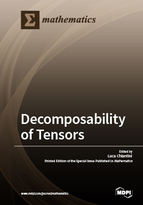Decomposability of Tensors
A special issue of Mathematics (ISSN 2227-7390).
Deadline for manuscript submissions: closed (28 September 2018) | Viewed by 16754
Special Issue Editor
Interests: algebraic geometry; projective geometry; multilinar algebra; commutative algebra; computer algebra; algebraic statistics
Special Issues, Collections and Topics in MDPI journals
Special Issue Information
Dear Colleagues,
Tensor decomposition has recently become a relevant topic, both for theoretical and applied mathematics, due to its interdisciplinary nature, which ranges from multilinear algebra and algebraic geometry to numerical analysis, algebraic statistics, quantum physics, signal processing, artificial intelligence, etc. The starting point behind the study of a decomposition relies on the idea that knowledge of elementary components of a tensor is fundamental to implement procedures able to understand and efficiently handle the information that a tensor encodes. Recent advances started with a systematic application of classical methods (some of them of geometric nature) to determine effective results on tensor decompositions. The methods range from the applications of the geometry of secant varieties in tensor spaces, to the study of symmetries in the decomposition of a specific tensor, to the determination of the sensitivity of a decomposition to small variations (deformations) of the data. Thanks to new applications of theoretic results, criteria for understanding when a given decomposition is minimal or unique, both for generic or specific tensors, have been recently introduced or significantly improved. New types of decompositions, of which elementary blocks can be chosen in a range of different possible models (e.g., Chow decompositions or mixed decompositions) are now systematically studied, and produce a deeper insight on the topic, with fruitful consequences on applications. The aim of this Special Issue is to collect papers that illustrate some directions in which recent research moves, as well as to provide a wide overview on several new approaches to the problem of tensor decomposition.
Prof. Dr. Luca Chiantini
Guest Editor
Manuscript Submission Information
Manuscripts should be submitted online at www.mdpi.com by registering and logging in to this website. Once you are registered, click here to go to the submission form. Manuscripts can be submitted until the deadline. All submissions that pass pre-check are peer-reviewed. Accepted papers will be published continuously in the journal (as soon as accepted) and will be listed together on the special issue website. Research articles, review articles as well as short communications are invited. For planned papers, a title and short abstract (about 100 words) can be sent to the Editorial Office for announcement on this website.
Submitted manuscripts should not have been published previously, nor be under consideration for publication elsewhere (except conference proceedings papers). All manuscripts are thoroughly refereed through a single-blind peer-review process. A guide for authors and other relevant information for submission of manuscripts is available on the Instructions for Authors page. Mathematics is an international peer-reviewed open access semimonthly journal published by MDPI.
Please visit the Instructions for Authors page before submitting a manuscript. The Article Processing Charge (APC) for publication in this open access journal is 2600 CHF (Swiss Francs). Submitted papers should be well formatted and use good English. Authors may use MDPI's English editing service prior to publication or during author revisions.
Keywords
- Tensor analysis
- Rank, border rank and typical rank
- Complexity
- Identifiability
- Secant varieties
- Segre and Veronese varieties
- Interpolation problems






